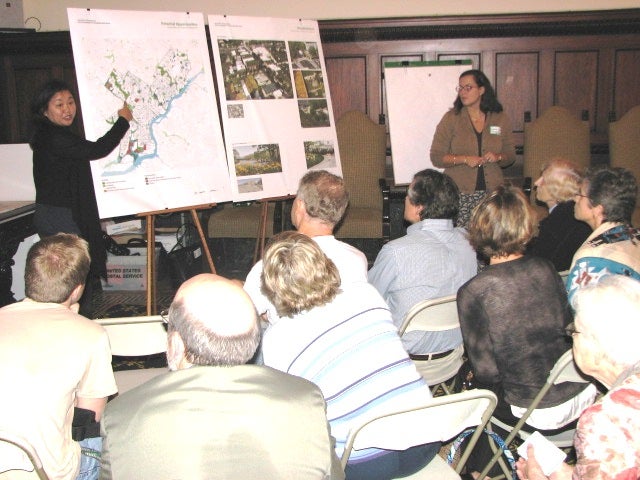GreenPlan Philadelphia tells it like it is

By Alan Jaffe
For PlanPhilly
The city that has been known in the past by the unfortunate sobriquet “Filthydelphia” is in the midst of a beautification project – a blueprint intended to benefit the ecology, economy and quality of life of all its residents.
GreenPlan Philadelphia, a cooperative effort of various city agencies and community groups, presented a progress report on its 1 1/2-year-old project Thursday night for about 100 Center City and nearby river ward residents, the first of six such meetings planned around the city this month.
For many people in the Mayor’s Reception Room, it was their first glimpse at what is hoped will provide a much needed roadmap for sustainable open space throughout Philadelphia and secure the funding to make it happen.
Alan Urek, director of strategic planning and policy for the City Planning Commission, defined sustainability as the “ways we use resources that don’t compromise future generations.”
The project has involved federal, state and city resources, including 14 Philadelphia government agencies, and numerous civic organizations, working on proposals that may take 15 to 20 years to realize, said Eva Gladstein, director of the Neighborhood Transformation Initiative. But she said it will be “a broad and flexible plan that can be around a long time.”
The foundation of GreenPlan includes portions of previous plans set out for Fairmount Park, watershed management and neighborhood improvement, Gladstein said. But it has added various ways to measure the city’s existing green space, the ecological and social goals desired by residents, and the benefits certain environmental steps will produce.
One of the measurements taken by GreenPlan has been the city’s tree canopy. Breaking down Philadelphia into geographic sections, the study found the trend has been a reduction of the canopy to a point that it covers less than one percent of Center City. The target of many cities is a 30 percent canopy, and Philadelphia has adopted that goal. Only one section of the city, the Germantown/Chestnut Hill area, exceeds that number, with 33 percent tree cover, and most fall far below.
The differences in percentage of tree canopy from one area of the city to another is a reflection of the “lack of equity” in Philadelphia, Gladstein said.
Looking closer at one-square-mile sections in South Philadelphia and an Allegheny Avenue neighborhood, GreenPlan found that the South Philadelphia section could realize $1.1 million in annual energy savings and pollution mitigation by increasing its tree canopy to 30 percent. Property values in that neighborhood would increase by $122 million, the study found.
Adding green roofs and tree cover to homes and other buildings in the Allegheny area would result in $640,000 in yearly energy savings and add $48 million to property values.
Similar savings and land values would occur wherever certain “actions and interventions” are adopted, Gladstein said. Besides increasing the tree canopy, steps include improving water infiltration in a variety of ways, use of rain barrels for water storage, and re-use of land for urban agriculture.
GreenPlan’s larger proposals call for the “greening” of streets with tree-lined medians and bike paths, rail corridors and stations bordered by hardy bushes and solar panels, and school yards blooming with gardens instead of covered in blacktop.
In small breakout groups convened after the presentation, residents offered their own ideas on what it will take to bring GreenPlan to fruition. Ursula Reed, a former Pennsport resident, said it will mean some consciousness-raising in her former neighborhood, where “people think trees are dirty.”
Others suggested zoning changes and zoning requirements in GreenPlan to ensure that businesses and residents meet tree-cover quotas and take other steps to improve the environment. Another resident suggested real estate tax incentives or credits for implementing improvements.
Gladstein said GreenPlan, which will be presented to the city administration in December, will include recommendations for governance and management.
Mayor Street stopped by the meeting to offer his support for the plan. He said when his fourth grandchild was born, and he held her for the first time, he wondered “what kind of world are we going to leave for this young lady. My conscience was pricked.”
GreenPlan provides “a lot of things we can do, and it can get people interested in it,” the mayor said. “This plan can make a huge difference in the quality of life and the sustainability of our environment.”
Gladstein noted that while GreenPlan is a long-term project, there are many immediate actions that can be taken by “individual blocks and individuals.”
“We want to move away from green plan to green action,” she said.
A list of steps to advance the project are available at the website, www.phila.gov/green.
Community meetings on GreenPlan are scheduled at the following locations this month:
Northwest Philadelphia – Joseph E. Coleman Northwest Regional Library: Tuesday, Oct. 9, 6:30-8:30 p.m.
Location: 68 West Chelten Avenue (Intersection with Green Street).
North Philadelphia – Free Library of Philadelphia – Lillian Marrero Branch: Wednesday, Oct. 10, 6:30-8:30 p.m. Location: 601 West Lehigh Ave. (between 6th and 7th Streets).
South Philadelphia – Fels South Philadelphia Community Center: Thursday, Oct. 11, 6-8 p.m. Location: 2407 South Broad St. (between Ritner and Porter Streets).
West Philadelphia – Microsoft High School of the Future: Tuesday, Oct. 16, 6:30-8:30 p.m. Location: 4021 Parkside Ave. (Intersection with Girard Avenue).
Northeast Philadelphia – Northeast Regional Library: Thursday, Oct. 18, 6:30-8:30 p.m.
Location: 2228 Cottman Ave. (Intersection with Oakland Street).
WHYY is your source for fact-based, in-depth journalism and information. As a nonprofit organization, we rely on financial support from readers like you. Please give today.






